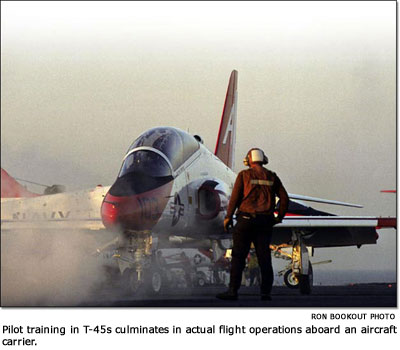| The total training package
For 10 years, the T-45 has been the
top jet trainer for U.S. Navy and Marine Corps pilots
BY KATHLEEN COOK

Like most 10-year-olds, it is fast, relatively small and likes to have
fun. But this 10-year-old is not a child, it's the Boeing T-45 Goshawk.
And it's the centerpiece of the U.S. Navy's T45 Training System (T45TS).
The Navy received its first distinctive red-and-white Goshawk in 1992
to meet the growing need for a tactically advanced trainer aircraft. Since
then, 1,628 Navy and Marine Corps pilots have earned their wings in the
T-45.
The T45TS was designed for one purpose: to provide the highest quality
undergraduate jet aircraft training for the men and women in the Navy
and Marine Corps. The core of the system is the T-45 Goshawk two-seat
carrier-suitable aircraft, based on the BAE Hawk light jet. Its flight
training capability is augmented by operational and instrument flight
simulators, computer-assisted classroom instruction, and a training integration
system that tracks all training activities.
 Most
importantly, the Goshawk gives student pilots an environment that very
closely resembles the planes they ultimately will fly — Boeing F/A-18
Hornets, AV-8B Harriers and other Navy and Marine Corps aircraft. Most
importantly, the Goshawk gives student pilots an environment that very
closely resembles the planes they ultimately will fly — Boeing F/A-18
Hornets, AV-8B Harriers and other Navy and Marine Corps aircraft.
Boeing provides on-site T45TS support at Naval Air Station Meridian, Miss.,
and Naval Air Station Kingsville, Texas. In addition to its pilot training
software and hardware, Boeing provides maintenance and supply support
for all Goshawks. "Our integrated system frees our customers to perform
their primary duty, which is out in the fleet, flying missions," said
Bob Feldmann, Boeing T45TS general manager.
"It's a total system," said Tom Sonderman, head of T45TS Integrated Logistics
Support, who has worked with the T-45 for the past 12 years. "With this
system, students have everything they need to earn their wings."
The T45TS also has saved the Navy money by cutting the number of hours
a student is required to fly before earning his or her wings. The T45TS,
which bundles computer-assisted classroom work and simulator training
with time in the Goshawk, has reduced the amount of flying time by 39.5
hours per student, or 13 percent. That has reduced the overall time to
train a student by 17 weeks.
"The T-45 is a superlative part of U.S. naval aviation," said Capt. Dave
Wooten, U.S. Navy program manager for the T-45. "We know that with this
aircraft our students are getting the best possible environment in which
to succeed, and the Navy is getting well-trained aviators who are ready
to take their place in the fleet."
The history of this system goes back to the early 1980s, when a team comprising
Douglas Aircraft Company and British Aerospace won the competition to
replace the Navy's T-2C Buckeye and TA-4J Skyhawk. The idea was to modify
the existing BAE Hawk for carrier-based operations.
"This was the first time I can remember any land-based aircraft being
converted to a carrier-suitable aircraft," Sonderman said.
Among the modifications required were a new slatted wing, newly designed
nose and main landing gear, and strengthened airframe to withstand the
stresses of carrier take-offs and landings. The aircraft also received
engine redesigns to provide more thrust, replacement of the Hawk's single
under-fuselage speed brake with dual side-fuselage brakes, and the addition
of carrier arrested-landing capability.
Since the first aircraft was delivered, Boeing has redesigned the cockpit
to reflect current cockpit configurations on Navy fleet aircraft. Today,
Boeing is in the process of proposing a further modification to existing
T-45A aircraft and simulators with the new "Cockpit 21" digital configuration.
The goal, according to Feldmann, is to make the transition from a training
squadron to a fleet squadron smoother and faster.
"The Goshawk's digital cockpit has displays, navigation and flying aids
very similar to F/A-18s and other fleet aircraft," he said. "So instead
of learning one type of instrumentation and moving on to something else,
these pilots are getting exposure to the environment they're going to
live with much earlier in their training."
"Once we finish the analog-to-digital conversion, we will have developed
a baseline design that will provide for future needs well into this century,"
Wooten said.
Current U.S. Navy requirements call for 234 T-45 Goshawks providing undergraduate
jet pilot training until at least 2035.
|